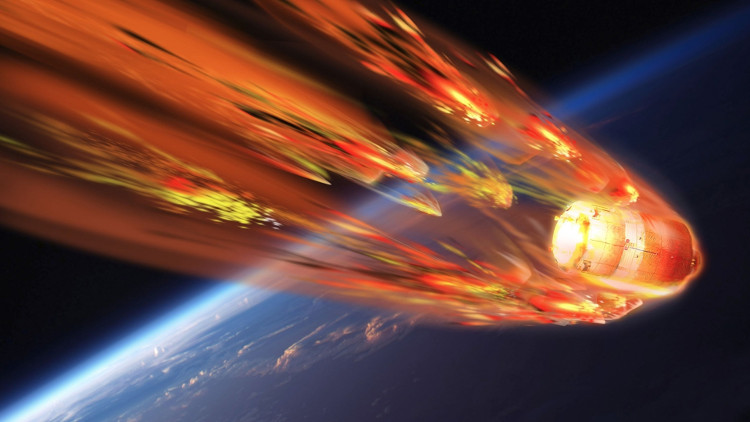The reason why China's 8.5-ton space station doesn't burn out when it falls
Large size and solid structure make Thien Cung 1 station not completely destroyed when it burns in the Earth's atmosphere.
Although China's Thien Cung 1 space station will fall out of control to Earth, the possibility of a station injuring people when landing very small, according to Newsweek. It is because humans are scattered over the surface of the Earth that there are so many gaps for a satellite to hit the ground without leaving any consequences.
However, the only reason the parts of Thien Cung 1 station were able to collide with the ground was due to the large size of the station . Hundreds of satellites fall out of orbit each year and are completely destroyed before hitting the ground due to the thick atmosphere surrounding the Earth.
"The Earth's atmosphere is very slow and very low. It is a very good but imperfect vacuum , " said Jonathan McDowell, astrophysicist at the Harvard-Smithsonia Center, who specializes in tracking launches and falling back into the satellite's atmosphere, said.

Thien Cung 1 station is expected to fall to Earth between March 30 and April 3.(Image: Outer Places).
That means even in the highest orbit around the planet, where the atmosphere is thinnest, all satellites are constantly colliding with airborne particles. Because satellites orbit around a speed of about 27,360 km / h, colliding with a small particle can cause it to fly a bit slower, similarly to preventing a swimmer from encountering water.
If a satellite is only going a little slow, it will only slightly lower, moving in orbit closer to Earth. But that makes the satellite fly around orbit faster . "As a result you will fly in a spiral. Each of the following orbits is smaller than the previous trajectory, " McDowell said.
The lower the trajectory, the thicker the atmosphere around the satellite and the stronger the drag, meaning the spiral effect increases rapidly. Finally, colliding with every particle in the air will cause the satellite to burn and fall from orbit to Earth.
This basic rule is true to the atmosphere on every planet, which is why the US Aeronautics and Space Administration (NASA) is forced to abandon the ship to plunge into Saturn's atmosphere and end its mission. Will also experience the same fate on Jupiter.
The whole process is somewhat difficult to predict because the magnitude of the resistance that the satellite encounters depends on its contact surface with the atmosphere.Satellite materials also affect the process of falling back into the atmosphere. Many satellites contain large amounts of aluminum, metals often burn off at the end of the spiral cycle. But the denser parts of the spacecraft often do not burn out. "Metal blocks will fall through the sky and darken to the surface of the Earth , " McDowell speculated. Most will fall into uninhabited and underdeveloped places on Earth.
Currently, scientists control most of the missile satellites on board, controlling the process of falling back in an uninhabited region like the South Pacific. This was supposed to happen with Thien Cung 1 station equipped with propulsion to control the falling position like most modern large satellites.
But Chinese authorities are concerned that the successor version of Thien Cung 2 station does not launch smoothly and wants to maintain Thien Cung 1 station so that the space program will not be interrupted. During that period of operation, the station's falling control mechanisms were broken, which is why the Thien Cung 1 station fell back, depending entirely on the atmosphere.
- The fall of satellites made the Earth
- Thien Cung 2 space station re-enters the atmosphere, being 'controlledly destroyed'
- Chinese space station caught fire in the South Atlantic sky
- China plans to launch Tiangong Space Station similar to ISS by 2020
- Overview of China's Thien Cung 1 Space Station
- How did the Soviet Union save the Saliut-7 space station?
- NASA celebrates 40 years of the first space station project
- Russian space station will replace the US ISS global surveillance
- China intends to operate the new space station in 2022
- By 2022, China will have the first international space station
- The stray 8.5-ton space station will create
- 10 most exotic waterfalls in the world
 Van Allen's belt and evidence that the Apollo 11 mission to the Moon was myth
Van Allen's belt and evidence that the Apollo 11 mission to the Moon was myth The levels of civilization in the universe (Kardashev scale)
The levels of civilization in the universe (Kardashev scale) Today Mars, the sun and the Earth are aligned
Today Mars, the sun and the Earth are aligned The Amazon owner announced a secret plan to build a space base for thousands of people
The Amazon owner announced a secret plan to build a space base for thousands of people India and its plan to build a space station orbiting the Moon
India and its plan to build a space station orbiting the Moon  The building uses heat from the human body as energy
The building uses heat from the human body as energy  Is the US preparing to build a military space station?
Is the US preparing to build a military space station?  The Chinese space station was hit by space debris
The Chinese space station was hit by space debris  China sent a new group of astronauts to the Thien Cung space station
China sent a new group of astronauts to the Thien Cung space station  Air conditioning system on the Chinese space station
Air conditioning system on the Chinese space station 